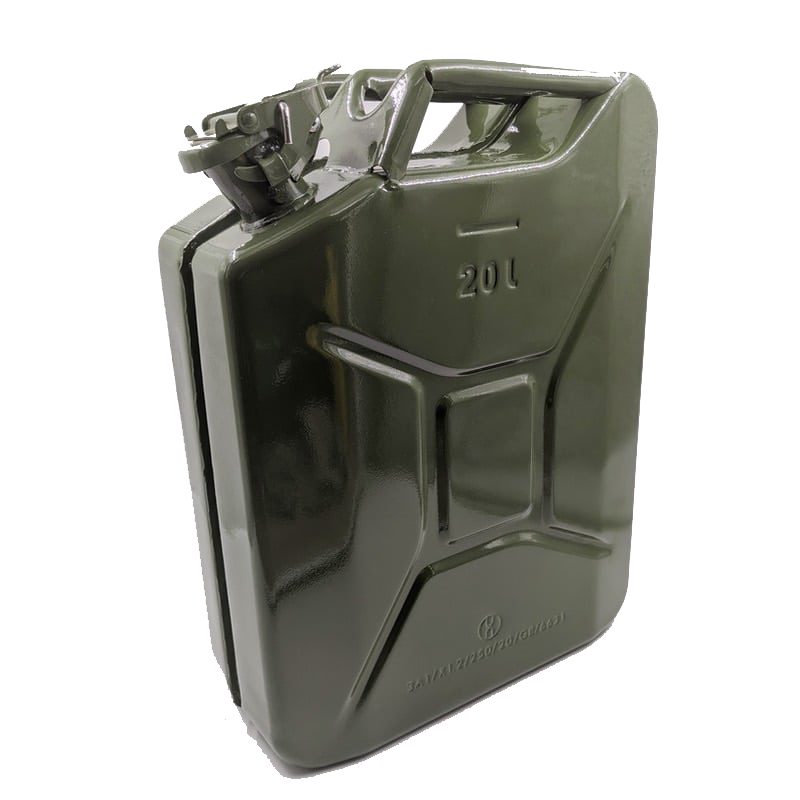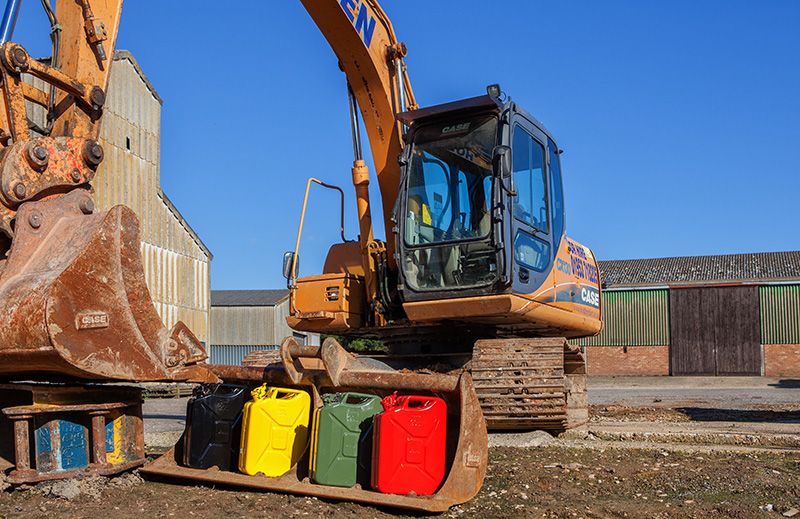Fuel Cans
The Difference Between Commercial & Domestic Jerry Cans
The history of the Jerry Can is rooted in military necessity and innovation. The iconic design of the Jerry Can, a robust and practical fuel container, can be traced back to World War II. In the early 1940s, as German forces were rapidly advancing across Europe, the need for a reliable and efficient means of transporting fuel became increasingly evident. The existing fuel containers were often inadequate, prone to leaks, and cumbersome for military use.
Recognising this critical need, German engineer Vinzenz Grünvogel played a pivotal role in developing a revolutionary design. The result was the iconic rectangular metal canister with three handles, a hinged lid, and a unique internal structure that minimised sloshing and facilitated stacking—a design that would later become known as the “Jerry Can.”
The name “Jerry Can” itself is derived from the slang used by Allied forces during the war, referring to German soldiers as “Jerries.” Jerry Cans quickly gained recognition for its durability, practicality and efficiency in transporting fuel across challenging terrains. Its success in addressing the logistical challenges of military campaigns led to its adoption by various nations and industries worldwide. Beyond its military origins, the Jerry Can has become an enduring symbol of functional design and has found applications in diverse fields, including agriculture, industry, and outdoor activities, showcasing the lasting impact of its innovative design.
What Are Domestic Jerry Cans?
“Domestic jerry cans” typically refer to fuel containers designed for household or civilian use. These cans are adapted from the military-style Jerry Can but are often modified for domestic purposes, such as storing and transporting fuel for personal use, emergencies, or outdoor activities. Domestic jerry cans are commonly used for storing fuels like petrol (gasoline), diesel, or kerosene.
These containers typically share some design features with the military Jerry Can, such as a robust build, a secure sealing mechanism, and handles for easy carrying. However, they may come in different sizes and materials to meet the specific needs of non-military users. The primary goal is to provide a safe and convenient means for individuals to store and transport fuel for various purposes, such as refuelling vehicles, powering generators, or using outdoor equipment.
Domestic jerry cans are an essential part of emergency preparedness kits and are also popular among outdoor enthusiasts, campers, and individuals in rural areas where access to fuel stations may be limited. They serve as a practical solution for safely storing and transporting small to moderate quantities of fuel for domestic applications.

What Are Commercial Jerry Cans?
“Commercial jerry cans” typically refer to fuel containers designed for industrial or business purposes. These cans are often larger in size and are intended for the bulk storage and transport of fuels in commercial settings. The design of commercial jerry cans may vary based on the specific needs of industries such as construction, agriculture, transportation or other sectors where significant quantities of fuel are required.
Commercial jerry cans share some characteristics with the traditional military-style Jerry Can, including a durable construction, secure sealing mechanisms, and handles for ease of handling. However, they are adapted to meet the demands of larger-scale operations. These cans are commonly used to store and transport fuels like gasoline, diesel, or other industrial fluids.
In commercial applications, these containers are crucial for maintaining a reliable and efficient fuel supply for machinery, vehicles, and equipment. They are often designed with features that facilitate easy pouring and filling, as well as safety measures to prevent spills and leaks during transportation.
Moreover, the term “commercial jerry cans” may not represent a standardised product category, and the features and specifications can vary based on the specific manufacturer and the intended industrial application.

Jerry Can Comparison
| Feature | Commercial Jerry Can | Domestic Jerry Can |
|---|---|---|
| Durability | Designed for heavy-duty industrial use | Suitable for household and outdoor applications |
| Size | Larger capacity for bulk storage and transport | Smaller to moderate size for personal use |
| Intended Use | Industrial and commercial fuel storage and transport | Household fuel storage and outdoor activities |
| Design Features | May have specialised features for specific industries | Adapted for convenience in domestic settings |
| Regulatory Compliance | Designed to meet industry and safety standards | Compliant with domestic safety regulations |
Comparing Metal Composition
The material composition of commercial and domestic jerry cans often varies to meet the distinct demands of their intended use cases. Commercial jerry cans, designed for heavy-duty industrial applications, are typically constructed from robust and durable materials capable of withstanding prolonged and rigorous use. These containers may employ high-grade plastics, steel, or other reinforced materials, ensuring resilience against harsh environmental conditions, frequent handling, and potential exposure to various chemicals. The emphasis on durability and longevity in commercial settings necessitates materials that can endure the challenges of industrial environments, making these jerry cans more robust and substantial.
On the other hand, domestic jerry cans prioritise practicality and user-friendliness for everyday household use. As a result, these containers often feature materials that strike a balance between durability and ease of handling. Common materials for domestic jerry cans include sturdy plastics or lightweight metals, offering sufficient strength for routine tasks without unnecessary bulk. The material selection for domestic jerry cans is often influenced by factors like portability, convenience, and affordability, making them well-suited for tasks such as refuelling lawnmowers, emergency preparedness, or other typical household needs. Overall, while both commercial and domestic jerry cans share a focus on functionality, their material compositions are tailored to meet the specific demands of their respective environments and use cases.

Certificates And Standards
The certifications and standards applicable to commercial and domestic jerry cans play a crucial role in ensuring product quality, safety, and compliance within their respective contexts. Commercial jerry cans, designed for industrial applications, often undergo rigorous testing and certification processes to meet industry-specific standards. These standards may include certifications for materials used, manufacturing processes, and adherence to safety regulations within the targeted sector. For example, jerry cans intended for transporting hazardous materials may need to comply with strict regulations outlined by organisations such as the Department of Transportation (DOT) or other relevant regulatory bodies. Additionally, commercial jerry cans may adhere to international quality standards to facilitate global trade and ensure interoperability within different regions.
Moreover, domestic jerry cans, geared towards household use, may comply with more general safety and quality standards. These cans often adhere to guidelines set by consumer product safety organisations or government agencies responsible for regulating household items. Certifications for domestic jerry cans may focus on aspects like child safety features, material toxicity, or compliance with basic safety regulations.
While the certification requirements are typically less industry-specific than those for commercial counterparts, ensuring compliance with established standards is essential to guarantee the safety and reliability of these containers in everyday household applications. Overall, whether for commercial or domestic use, certifications and standards are critical benchmarks that ensure jerry cans meet the necessary criteria for quality, safety, and regulatory compliance within their intended environments.
Price Comparison
The pricing of commercial and domestic jerry cans reflects the differences in their design, materials, and intended use, making it an essential consideration for consumers in various sectors. Commercial jerry cans, often engineered for heavy-duty industrial applications, typically command a higher price point due to their larger capacities, specialised features, and robust construction. The increased costs may also be associated with adherence to industry-specific standards, certifications, and materials designed to withstand the harsh conditions of commercial environments. Additionally, advanced pouring mechanisms, security features, and customisation options contribute to the higher pricing of commercial jerry cans, as they cater to the specific needs of industrial sectors such as construction, agriculture, or transportation.
Furthermore, domestic jerry cans are generally more budget-friendly, reflecting their focus on practicality and simplicity for everyday household use. These cans are designed with the average consumer in mind, emphasising affordability while still meeting essential safety and quality standards. The reduced size, simpler features, and more economical materials contribute to lower production costs and, consequently, a more accessible price point for consumers.
Domestic jerry cans are often suitable for routine tasks like refuelling lawnmowers, emergency fuel storage, or other common household needs, making them a cost-effective choice for individual consumers who do not require the specialised features of their commercial counterparts. In summary, the pricing of commercial and domestic jerry cans aligns with their intended use, features, and the specific demands of their respective target markets.

Pouring Mechanisms
The pouring mechanism is a crucial aspect of both commercial and domestic jerry cans, influencing the ease of use, efficiency, and safety during fuel transfer. In commercial jerry cans designed for industrial applications, pouring mechanisms often feature advanced designs to facilitate efficient and controlled pouring, especially when dealing with larger quantities of fuel. These mechanisms may include integrated funnels, precision spouts, or even specialised dispensing systems, tailored to the specific needs of industrial sectors such as construction, agriculture, or transportation. The emphasis is on optimising the pouring process for quick and precise fuel distribution while minimising the risk of spills or accidents in demanding industrial environments.
On the other hand, domestic jerry cans prioritise user-friendliness and simplicity in their pouring mechanisms. While still designed for efficient fuel transfer, domestic jerry cans often feature more straightforward spouts or pouring systems suitable for everyday household use. The emphasis is on convenience, allowing users to handle the pouring process easily without the need for additional tools or complex mechanisms. The spouts on domestic jerry cans are typically designed for a more general audience, ensuring that individuals with varying levels of experience can use them with confidence for tasks like refuelling petrol garden tools, generators, or other common household needs.
In addition, the main difference in pouring mechanisms between commercial and domestic jerry cans lies in the level of complexity and specialisation. Commercial jerry cans incorporate advanced pouring features tailored to industrial demands, while domestic jerry cans prioritise simplicity and ease of use for everyday household applications.
Stackability And Storage
The design of commercial and domestic jerry cans differs when it comes to stackability and storage considerations, aligning with the distinct requirements of their intended environments. Commercial jerry cans, engineered for industrial use, often prioritise efficient storage solutions in large-scale settings. These cans are typically designed to be stackable, allowing for easy organisation and space optimisation in warehouses, industrial facilities, or transportation settings. Their structural design may include features such as interlocking grooves or uniform dimensions to facilitate stable stacking, ensuring that a significant number of cans can be stored in a compact space. This stackability is crucial for industries where large quantities of fuel need to be stored and transported efficiently.
Conversely, domestic jerry cans, intended for household use, may prioritise compactness and ease of storage in more confined spaces. While some domestic jerry cans are stackable to a certain extent, their designs often cater to individual or small-scale storage needs. The emphasis is on practicality for residential environments, where storage space may be limited. Domestic jerry cans are typically smaller in size and may feature designs that facilitate easy placement in garages, sheds, or other common household storage areas without requiring significant stacking.
In summary, the main difference in stackability and storage between commercial and domestic jerry cans lies in their respective designs to meet the scale and storage conditions of their intended environments. Commercial cans prioritise efficient stacking in large-scale industrial settings, while domestic cans emphasize practical storage solutions for individual or household use.
Colour Coding
Colour coding in commercial and domestic jerry cans serves distinct purposes based on their intended environments and use cases. In commercial settings, where precision and safety are paramount, colour coding is often employed as a visual aid to quickly identify the type of fuel or fluid contained within the jerry can. This practice helps prevent errors and ensures that the right fuel is used for specific machinery or equipment. The colour-coding system may adhere to industry standards, where specific colours represent different types of fuels or fluids, making it easier for workers in industrial sectors such as construction, agriculture, or transportation to manage and handle the cans efficiently.
Conversely, colour coding in domestic jerry cans is typically more straightforward and user-friendly. While colour-coding practices may still be applied, they are often designed with a focus on general safety and easy identification for household users. For example, a red jerry can signify gasoline for lawnmowers, while a blue one may indicate kerosene for outdoor lamps or heaters. The colour-coding system in domestic jerry cans is usually tailored to common household fuels and fluids, providing a clear and intuitive way for individuals to identify and use the right can for their specific needs.
Moreover, the main difference in colour coding between commercial and domestic jerry cans lies in the complexity and specificity of the coding system. Commercial cans employ precise colour codes adhering to industry standards, while domestic cans utilise a more user-friendly system tailored to common household applications.

Anti Tampering
Anti-tampering features in commercial and domestic jerry cans serve distinct purposes based on the security requirements of their respective environments. In commercial jerry cans designed for industrial applications, where the risk of tampering or unauthorised access may be higher, sophisticated anti-tampering features are often integrated. These features may include lockable lids, tamper-evident seals, or specialised locking mechanisms. The goal is to enhance security and prevent unauthorised access to the fuel or fluids stored in the cans, ensuring the integrity of the contents during transportation, storage, or use in industrial sectors such as construction, agriculture, or transportation.
Conversely, anti-tampering features in domestic jerry cans are typically simpler, addressing the more straightforward security needs of household users. While these features may include basic locking mechanisms or child-resistant closures, they are generally designed with ease of use in mind. The primary purpose is to deter accidental access rather than thwarting deliberate tampering. These features aim to provide a basic level of security, especially in households with children, without introducing complexities that might hinder regular usage for routine tasks like refuelling garden mechanical tools or storing emergency fuel supplies.
Discover Wavian For Premium Quality Jerry Cans
Introducing a world of superior fuel containment with Wavian, where we bring you the pinnacle of quality and innovation in both domestic and commercial jerry cans. Whether you’re a homeowner seeking reliability for everyday tasks or an industry professional requiring robust solutions for heavy-duty applications, Wavian has you covered.
Why Choose Wavian?
Industry-Leading Standards: Our commitment to excellence is reflected in our jerry cans, meeting and exceeding the highest industry standards for both domestic and commercial use.
Diverse Range: Explore our extensive collection, featuring specialised commercial jerry cans engineered for industrial demands and user-friendly domestic cans tailored for household convenience.
Innovative Features: From advanced pouring mechanisms to security-enhancing anti-tampering features, Wavian jerry cans are crafted with cutting-edge technology to ensure optimal performance in any setting.
Reliability You Can Trust: With Wavian, you’re not just getting a fuel can; you’re investing in peace of mind. Trust in the durability, safety, and precision of our jerry cans, designed to meet the diverse needs of our valued customers.
Fuel Your Future with Wavian – Where Quality Knows No Boundaries!
Explore our comprehensive range and elevate your fuel storage and transportation experience. For inquiries or to place your order, call us at +44 01508 493 647. Wavian – Empowering Your Fuel Solutions with Unmatched Excellence!

